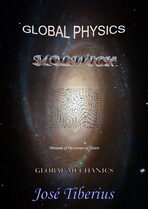2.b.2. Gravity at the atomic distances. Mass and specific gravity or relative density
The tension of the longitudinal curvature of filaments in the reticular structure of matter or Global Aether is the origin of gravity. Consequently, at short distances, the force of gravity will depend on the three-dimensional shape of the said reticular structure, which will depend on the presence of mass.
On another hand, the concept of mechanical energy at atomic distances is not as useful as in the case of the movement of bodies. Although the Law of Conservation of Energy exists within a closed system, the movement and spatial location of Global Aether itself will affect potential gravitational energy and gravitational kinetic energy; as we discuss in the book on the Law of Global Gravity.
In the section on electron configuration within the new theory of the Global Atom of this book, we will analyze the mass, the electromagnetic energy and force of gravity at atomic distances, all together. Logically, it will also affect characteristics of the molecular structure, the mass and specific gravity or relative density, even though many other factors exist, such as molecular cohesion or typical intermolecular bonds of solids.
Specific gravity or specific mass is a relative measurement of the density of an element, and it will depend on the concentration of mass per unit of volume for each element. Said concentration of mass would vary with the three-dimensional molecular structure and mass number of the atoms.
At the same time, the molecular bonds mainly depend on the characteristics of the electromagnetic field, but this field tends to cancel itself out between the positive and negative charges of the atoms and ions. In this way, sometimes, the gravity at short distances becomes more relevant.
We will have to wait for the definition of electromagnetic energy, its origin and what mass is, to understand better the complete model of the gravitational field and the specific gravity, specific mass or relative density.
Nevertheless, it is convenient to state in advance two crucial concepts regarding the reticular structure of matter that supports the gravitational force at atomic distances.
The two following phenomena will affect the configuration of the atomic nucleus and its electrons, the molecular structure, and the specific gravity or specific mass:
Repulsive force of gravity
This phenomenon occurs very near the atomic nucleus; when the mass of the neutron separates the elastic filaments of a three-dimensional reticule of Global Aether, it forces said filaments to become concave concerning the neutron itself.
In other words, due to the tension of the longitudinal curvature, the gravitational force will operate towards the exterior because of the convexity. The configuration means the sense –of orientation– of the spatial vector in the direction of the gravitational force inverts. A little arrow on top of the affected magnitudes usually represents this vector.
The force of gravity changes its sign and, when this happens, there will be an inflection point where it cancels out. In this way, it will no longer be necessary to use the uncertainty principle from the theory of Quantum Mechanics to explain why electrons do not fall into the nucleus of the atom.
Regardless of the previous paragraph, as we will see in this book, electrons do not fall into the nucleus of the atom because their mass has a slightly different nature than the mass of neutrons or protons, and their movement has unusual characteristics.
Repulsive force of gravity 
In the case of homogenous dissolutions in liquids, the dissolved element will tend to expand due to the effect of repulsive gravity. Even if it is small, it will exist because of the additive property of the forces of gravity, although the distribution of the electromagnetic field at the molecular level of both liquids can also be significant.
Another effect of repulsive gravity will be the general tendency of liquids to have a lower density than solids and, as a result, specific gravity or specific mass smaller than solids and bigger than gases, for one same element.
A similar line of argument justifies the volume of gasses and the pressure for a specific temperature. By playing around with these variables, one can manage to vary the density and the specific gravity of gases; this aspect is more relevant when conducting them through pipes.
The braking force of gravity
It is a vector modulation of the gravitational force due to twists in the reticular structure of Global Aether.
Mass does not only have a gravitational effect when provoking a significant increase in the tension of the longitudinal curvature but is also associated with electromagnetic energy because it is curls or whirlpools of Global Aether itself.
Restrained force of gravity 
As we can see in this figure, the twists in Global Aether will also provoke a reversal of the orientation of the force of gravity, which will go from being a force of attraction to being a force of repulsion or braking force, at very short distances.
The braking force of gravity will have relevant effects on the configuration of the atomic nucleus and of molecules. As we will see later on, the electrons imply a twist in the Global Aether, similar to the one in the figure.
If the temperature associates in some way with the electromagnetic field, the pressure will be associated with the braking gravity and, to a less extent, with the repulsive gravity. Although in such an elastic physical model, all the forces are interrelated and tend to balance themselves out.
Note that up until now we have not introduced the electromagnetic interaction, which –together with the standard gravitational interaction and its vector modulation due to the two reasons previously stated– will determine the underlying atomic structure, the molecular structure and eventually, the density and specific gravity or specific mass of the materials.
A significant aspect is that these changes or modulations of the gravitational force could make the equality of the Gigachron experiment always be correct and could generalize the validity of the fundamental equation of Global Physics.
[ G * g = c² * h * R * n ]
g = [ c² * h * R / G ]
Furthermore, the analysis of the new atom configuration will mainly deal with the demarcation of the equilibrium points concerning all the current forces.
2.b.3. Indirect gravity
It is an obvious consequence of the gravitational model of Global Mechanics, but we had never thought of it before because gravity force is the result of all of its components. Nevertheless, given the high number of its components, indirect gravity could provide half the force of gravity.
If gravity is a consequence of the longitudinal tension of the filaments of the Global Aether, the model implies that the size of the cells of this net will not only depend on the direct effect of mass generating the gravitational field, but also on the size of the adjacent cells. The name of indirect gravity comes from this idea, as the size of the adjacent cells will themselves depend on the global gravitational field, with its own direct and indirect effects.

In short, what produces the longitudinal tension is the gradual decrease of the abovementioned size or the reticules with distance. This decrease will be a consequence of the elastic effect of the filaments, which directly join the cell with the mass that produces the field, as well as all the filaments or possible paths between the cell and the mass –within an angle that does not cancel out the resulting indirect forces.
From this point of view, gravity does not configure as a single force, which tends to join two masses, but rather as the result of a multitude of forces, where not all the directions pass through the masses. One would have to measure the aforementioned elastic effects using mathematical models, to analyze the possibility of asymmetric effects in particular situations.
Another aspect of indirect gravity is that its importance could have more relevance at atomic distances. One could think that if indirect effects do indeed exist upon mass, in the case of a gravitational field formed by two or more masses, these effects could have a certain degree of asymmetry.
